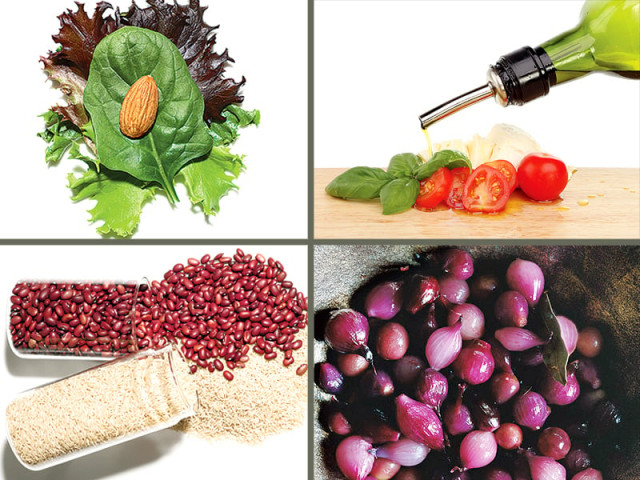
Epidemiologist David R Jacobs, Ph D, of the University of Minnesota calls it food synergy, and he, along with many other nutritionists, believes it might explain why Italians drizzle cold-pressed olive oil over tomatoes and why the Japanese pair raw fish with garlic! As compiled by organicgardening.com, Self magazine and Men’s Fitness magazine eat these food stars together and get glazed with health.
Combo 1: Onions and grapes

Fights: Allergies, cancer, weight gain
Quercetin is a powerful plant-derived antioxidant especially concentrated in onions. It’s been shown to help relieve allergy symptoms and offer significant cardiovascular protection. Meanwhile, the polyphenol antioxidant catechin, found in high doses in grapes, can help prevent cardiovascular disease, cancer, and neurological disorders, and may also help you lose weight. It is a weird food combination no doubt, but together, these foods may inhibit blood clots and enhance overall heart health. Add sliced red grapes and diced onion to your chicken salad, or mingle them with a few other healthful ingredients such as coriander to make a chutney as a perfect complement to your chicken tikka.
Combo 2: Garlic and fish

Fights: Inflammation, blood pressure, cholesterol
Fish is one of the major sources of long-chain omega-3 fats. They’re also rich in other nutrients such as vitamin D and selenium; high in protein, and low in saturated fat. The omega-3 fatty acids help lower blood pressure, heart rate, and triglycerides; improve blood-vessel function; and reduce inflammation. We recommend you eat one to two 3 oz servings (as much as a palm of your hand) of fatty fish like salmon, herring, mackerel, or sardines a week. “Cook your fish with garlic to make an even bigger impact on your blood chemistry,” says Magee. Researchers at the University of Guelph tested the effects of health-superstar garlic and fish, taken alone and together, on men with moderately high blood cholesterol. The combination lowered total cholesterol, LDL cholesterol, and triglycerides.
Combo 3: Green veggies and almonds

Fights: Cataracts, cancer, heart disease
Bright green vegetables are rich in plant pigments like chlorophyll that can reduce your risk of heart disease, cataracts, and cancer. However, they need to be eaten with a small amount of absorption-boosting monounsaturated fat, such as that found in almonds. An Ohio State University study measured how well phytochemicals from a mixed green salad were absorbed when eaten with or without almonds. The nut’s fatty acids helped subjects absorb 8.3 times more alpha-carotene, 13.6 times more beta-carotene, and 4.3 times more lutein than those who ate their salads plain. “This is a great argument against fat-free salad dressings,” says Magee, who also suggests adding sliced almonds to salads. “When plant sterols are combined with almonds, the LDL cholesterol-lowering effect is greater than with plant sterols alone.”
Combo 4: Red beans and brown rice

Fights: Cancer, diabetes, heart disease, weight fluctuation
Jam-packed with protein, fiber, vitamin B12, magnesium, and potassium, red kidney beans or our very own lobia really are a wonderful addition to your diet. Eating beans can help prevent colorectal cancers and heart disease, as well as reduce blood cholesterol and stabilise blood sugar levels. Brown rice, on the other hand, is a whole grain, meaning that both the germ and the bran parts of the grain have been preserved, unlike in our commonly consumer white rice and therefore is high in magnesium and fiber.
Rice and beans are usually inexpensive and readily available, and, when eaten together, form a complete protein. A protein is “complete” if it contains an adequate proportion of all nine of the essential amino acids (those that can’t be made by our bodies and therefore must be ingested). A cup of red beans with half a cup of brown rice provides 327 calories, 1g of fat, 42.5g of carbohydrates, 18g of fiber, and 18.5g of muscle-building protein — a gut wrenching low calorie option!
Combo 5: Tomatoes and Olive oil

Fights: Cancer, loss of eye vision
Tomatoes are rich in lycopene, a pigment-rich antioxidant known as a carotenoid, which reduces risk of cancer and cardiovascular disease. Fats make carotenoids more bio-available, a fact that makes a strong case for eating mum’s homemade kachumar drizzled with olive oil. “This also has a Mediterranean cultural tie-in,” says registered dietitian Susan Bowerman of California Polytechnic State University. “The lycopene in tomato products such as pasta sauce is better absorbed when some fat (like olive oil) is present than if the sauce were made fat-free.” This may also explain why we love olive oil drizzled over fresh tomatoes. And when it comes to salads, don’t choose low-fat dressings. A recent Ohio State University study showed that salads eaten with full-fat dressings aids with the absorption of another carotenoid called lutein, which has been shown to benefit vision.
Published in The Express Tribune, November 8th, 2014.
Like Life & Style on Facebook, follow @ETLifeandStyle on Twitter for the latest in fashion, gossip and entertainment.


















COMMENTS
Comments are moderated and generally will be posted if they are on-topic and not abusive.
For more information, please see our Comments FAQ